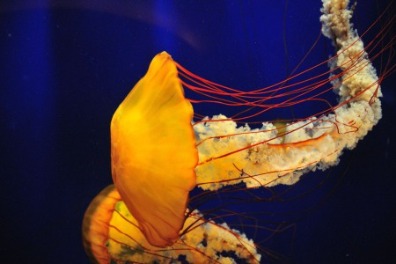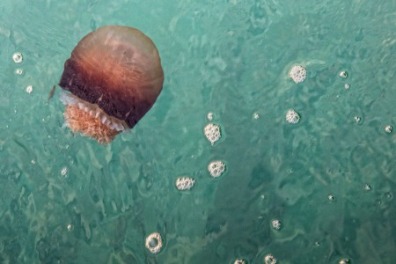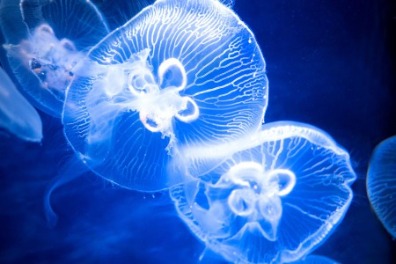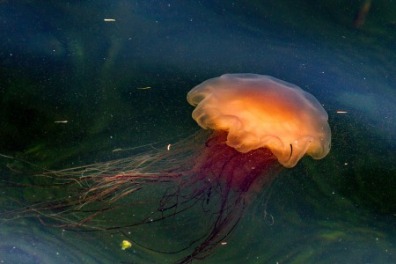Learn About 4 Jellyfish You Might See at the Beach and How to Be Safe

Sunset Beach is home to many fascinating marine species that help make up the beauty of the island. One such species that is beautiful and interesting to learn about are jellyfish. Sunset Beach has several different kinds off its coasts, some of which include the Atlantic Sea Nettle, the Cannonball Jellyfish, the Moon Jellyfish, and the Lion's Mane Jellyfish. In this blog, we'll learn more about them and what to do should you have a not-so-pleasant encounter with these docile creatures.
And if you're looking for the best places to stay on Sunset Beach this year, browse our furnished beach vacation rentals that offer fully equipped kitchens, stylish décor, and beautiful views of the island!
General Information About Jellyfish
General Information About Jellyfish
The first thing to know about jellyfish is that they can turn a great day at the beach into a not-so-fun day or, worse, a trip to the hospital. So, check with local authorities or scan your environment at the beach to ensure you don't have an incident with them.
An interesting fact about jellyfish is that they're not fish. Instead, they are invertebrate marine animals with dome-shaped bodies. They don't have a backbone, which is a distinct feature of fish. Some people refer to them as “jellies” for this reason.
Some species use their dome for water propulsion to swim, while others use their tentacles in a wave-like pattern to propel themselves through the water. They use their stingers to catch prey by injecting them with venom. For this reason, it is wise to avoid jellyfish on the beach, whether dead or alive, because they can still sting you either way.

Atlantic Sea Nettle
One of the most common jellyfish is the Atlantic Sea Nettle. It is the second largest found in North Carolina and along the coast of Sunset Beach. This species has a noticeable bell-shaped body and long tentacles that trail below it.
It can vary in color, but it is usually brown or yellow with red tentacles. Since they can give a very painful sting, it is wise never to handle one on the beach and swim away if you find one in the water.
Cannonball Jellyfish
These jellyfish are also known as cabbage head jellyfish due to their round shape, resembling cannonballs. They do not have long tentacles but appendages that look like fingers hanging down from the dome.
It is the least harmful to humans, with a very weak sting, and one of the most abundant species. Its texture is thick and rubbery, and its colors are usually white or brown, with some purple or blue hues.


Moon Jellyfish
These jellyfish look like they come from another world with their translucent and delicate appearance. Their dome is saucer-shaped, and their tentacles are short.
They swim using pulsating movements of their bell but have to rely more on the ocean currents to move through the water.
Lion's Mane Jellyfish
Lion's Mane Jellyfish is one of the largest species in North Carolina, with tentacles several feet long. It's easy to identify due to it being the only orange jellyfish.
They are more commonly found around North Carolina in the winter because they prefer cooler water.
Their sting is on a moderate level, and while painful and uncomfortable, it should be easily treatable in most cases. Their diet consists of small fish, which they catch in their tentacles.

What To Do If You Get Stung by a Jellyfish
Before entering the water, always check the area for any on the beach or in the water. If you want to be extra cautious, check with local authorities or websites that may have warnings about jellyfish blooms.
A jellyfish bloom is when many jellyfish gather in groups and end up close to shore. Sometimes these blooms can end up on the beach. Steer clear by swimming away or not going near them on the beach. If you encounter a jellyfish, stay calm. Let others know of its presence and keep children and pets away.
- If you get stung, get out of the water immediately and alert others for help.
- If you have tentacles sticking in your skin, use tweezers, a credit card, a stick, or another object to remove them from your skin. Do not use your bare hands so you don’t get stung again.
- Once you've removed the tentacles, rinse the affected area with seawater but never fresh water, which could worsen the stinging and burning. If you have a first aid kit with a vinegar solution or store-bought solution for jellyfish stings, use that to clean it and try to remove any remaining tentacles, but don't rub the area.
- If you're experiencing intense pain, use ice, a cold pack, or even cold water to help reduce swelling and take any over-the-counter pain medication if needed.
- Do not apply fresh water, alcohol, ammonia, or urine to the wound. It can make the pain exponentially worse.
- If you experience any other conditions related to the sting, such as nausea, difficulty breathing, or chest pain, try to remain calm and seek immediate medical attention if you think you’re having an allergic reaction.
Taking precautions before going to the beach reduces your chances of being stung. Check reports, scan the area for jellyfish, and take a first aid kit with a vinegar solution, tweezers, and gloves. And if you do get stung, you can try to mitigate the pain with appropriate first aid.
These intriguing creatures make up an essential part of the ocean's ecosystem. They are a significant food source for sea turtles, fish, seabirds, and other marine organisms. Jellyfish are fascinating and make great subjects to teach children about beach safety, respecting wildlife, and keeping our ecosystems healthy. You can also learn more about marine life at the Museum of Coastal Carolina in Ocean Isle Beach for a truly educational experience and fun.
If you're looking for exceptional accommodations on Sunset Beach, we have vacation rentals you will love. Browse our vacation rentals for beautiful properties that will make you feel like you're in a home away from home. They all have unique styles, amenities, and gorgeous home décor to make you fall in love. Browse now and book your vacation with us today!

Want to learn about some creepy and cool creatures of the sea?
Crazy, Creepy Creatures of the Atlantic That Will Delight Your Kids.










